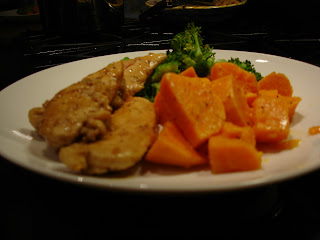
You never know what kind of bounty you might have in your own yard if you just moved into a new place. Even if you aren't a gardener, check it out and you might re-discover what fruit is supposed to taste like. Most of what we buy in the stores is not tree ripened and ultimately tasteless. Just one or two generations ago, people used to grow and harvest their own varieties of fruit and vegetables. They canned and preserved what they couldn't eat to keep enjoying their crops through the winter months and to share with friends/family. I am going to try to plant one of those cherry plum trees myself from the pits. I don't care how messy they are too tasty to risk losing. Plus I know my family, friends and the birds will enjoy them if I can get them to grow.
I prefer to bake with fresh fruit and I tend to freeze extra for the winter months. I have been eating many plums every day since I picked them but plan to make a plum dessert with more of my bounty. The following are two recipes for plum desserts;
- 6 tablespoons white sugar, divided
- 14 Italian prune plums, halved and pitted
- 3 eggs
- 1 1/3 cups milk
- 2/3 cup all-purpose flour
- 1 1/2 teaspoons grated lemon zest
- 2 teaspoons vanilla
- 1 pinch salt
- 1/2 teaspoon ground cinnamon
- 2 tablespoons confectioners' sugar
********************************
Plum Cobbler
Preheat to the oven to 425 degrees F.
FILLING
- 7 cups of pitted plums, cut in quarters
- 1 1/4 cups of sugar (usually plums are a bit tart but the ones I picked are very sweet so I will reduce this to 3/4 cup)
- 2 tablespoons of lemon juice
- 4 tablespoons of butter (1/2 stick)
Place the prepared plums in a 8-inch square baking pan and sprinkle with the sugar. Drizzle on the lemon juice and dot the plums with butter. Set aside to make the biscuit topping.
BISCUIT TOPPING
- 1 cup of flour
- 2 tablespoons of sugar
- 1/4 teaspoon of salt
- 2 teaspoons of baking powder
- 4 tablespoons of butter (1/2 stick), chilled
- 6 tablespoons of milk
Combine the dry ingredients in a large mixing bowl and stir them together using a fork. Cut the butter into bits, drop into the bowl and work it into the dry ingredients using your fingers, a pastry cutter or two knives. You want it to be a mixture of fairly even and fine crumbs. Slowly add the milk while stirring constantly with the fork.
There are two options for covering the cobbler. My preference is the spoon the biscuit dough over the top so you can see the fruit and juice bubble through. Then you can ignore the need of adding a separate glaze.
However, you can also completely cover the top. So if you prefer this second method, continue with the following steps; gather the dough together and place on a lightly floured surface. Knead 8 to 10 times, until dough it fairly smooth then roll or pat the dough into a shape that will cover your baking dish. Place the dough over the prepared fruit, pressing it down around the edges. For a glazed crust, drizzle 2 tablespoons of melted butter over the top and sprinkle 1 or 2 tablespoons of sugar over that.
Bake the cobbler for 35 to 45 minutes or until the juices are bubbling, the crust is golden brown and the fruit is tender. Remove from the oven and place on a rack. Serve warm or room temperate.
*************************
Happy harvesting!





